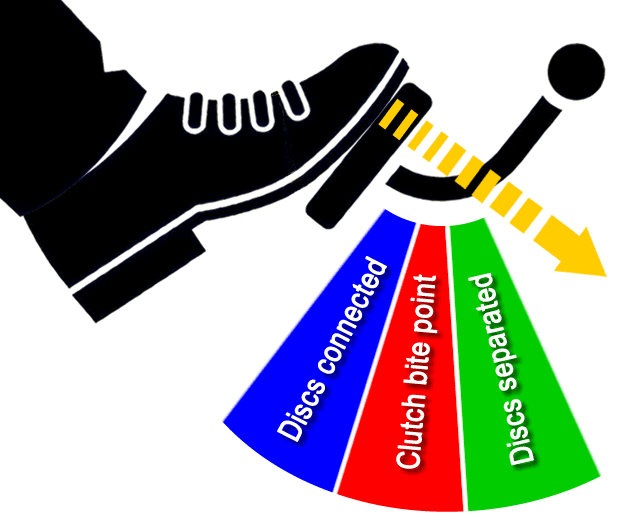How to Find the Clutch Bite Point
For some learner drivers, finding the clutch bite point is an easy procedure each and every time. But for others, the clutch bite point can be the bane of every driving lesson. In this tutorial, we’re going to explain how to find the clutch bite point.
If you have read the learning the car clutch for beginners tutorial, you’ll know that the car clutch consists of two friction discs that separate or connect depending on whether the clutch pedal is pressed or released. The following diagram illustrates approximately where the clutch bite point is when the pedal is pressed down.

From the clutch being fully pressed down to the floor to it being totally raised up, the clutch bite point is often roughly half way up, though it does vary on each car.
All car clutches are different. They have a different feel to them, they all require different levels of effort for pressing the pedal and they all have a bite point that’s in a slightly different place throughout the clutch pedal’s working travel.
Clutch operation also changes over time. Essentially, the more use a car clutch has, the more worn it becomes and the more worn it is, the higher the bite point.
Preparation
It’s always safest to start with the basics such as finding the clutch bite point in a quiet area, such as the back of a large car park that’s not too busy, or a quite residential street.
Footwear is also important. Wearing flat shoes with thin soles allows you to feel the pedals better and as such, you’ll be able to better gauge where the bite point is.
Finding the Bite Point from a Stationary Position
When the car is in motion and you’re changing up and down gears, there’s no need to find the clutch bite point. Due to the car having momentum, you’ll not stall the engine. If the car stationary, you will need to find the bite point to get moving. Finding the clutch bite pint in this situation is important for:
- Moving off from a stationary position
- Making progress in slow moving traffic
- Carrying out a manoeuvre
For learning the clutch bite point, you should practice two methods:
- Finding the clutch bite point with the handbrake on
- Finding the clutch bite point with the handbrake off
This tutorial primarily deals with finding the clutch bite point and not with observations and signalling. Those specifics will be covered in later tutorials. Always ensure that before moving the car that it is safe to do so by observing to the rear, the sides and in front of the vehicle.
Finding the Clutch Bite Point with the Handbrake on
This is the technique often used by learner drivers of manual cars when they’re starting out because it keeps the vehicle secure and stationary and can help in reducing the likelihood of stalling the engine.
- With the engine started and the handbrake on, fully press the clutch pedal to the floor.
- Select 1st gear.
- Gently apply a little pressure to the accelerator pedal and slightly increase the engine revs. If you have a tachometer (rev counter), increase the engine speed until it’s about 1500 rpm, or between the 1 and 2 digits.
- Now very slowly begin to raise the clutch pedal. When the clutch discs just start to come together, this is the bite point. You’ll know how to find the clutch bite point by the sound of the engine changing and the rear of the car may slightly lower.
- At the bite point, hold the clutch pedal still.
- Release the handbrake.
- Very slowly continue to lift the clutch.
- Once the car has momentum, think of a quick walking pace, you can smoothly release the clutch pedal all the way up.
Keep practicing this technique until you gain confidence and so that you can carry it out reasonably quickly, but ensure moving off is smooth and under control.
Finding the Clutch Bite Point with the Handbrake off
Once you have gained confidence with finding the clutch bite point with the handbrake on, begin practicing moving off with the handbrake off. This is the technique that more experienced drivers use because when mastered, it’s easier, quicker and contributes to less wear on the clutch. It’s important to practice finding the clutch bite point with the handbrake off while parked on a level surface to avoid rolling.
- With the engine started and the handbrake off, fully press the clutch pedal to the the floor and with your right foot, firmly press the brake pedal.
- Select 1st gear.
- Take your right foot from the brake pedal and apply a little pressure to the accelerator. Around 1500 rpm should do it.
- Begin to raise the clutch pedal and slow down when you reach the bite point. You’ll know you’ve reached the bite point because the car will begin to move.
- Apply a little more pressure to the accelerator and as the car gains momentum, fully release the clutch pedal.
Keep practicing this technique until you can move off reasonably quickly and without stalling the engine. Ultimately aim to apply pressure to the accelerator pedal and raising the clutch pedal simultaneously. Using this technique takes time and practice to master, but it’ll be far easier to drive when you get the hang of it.